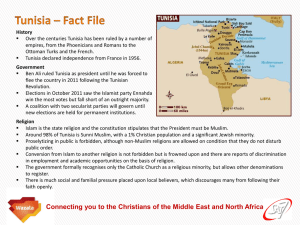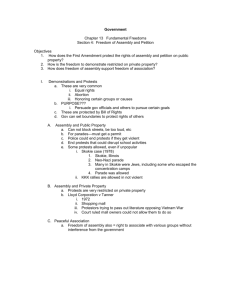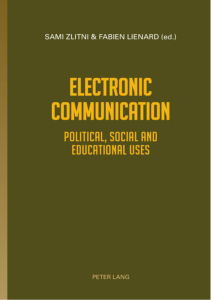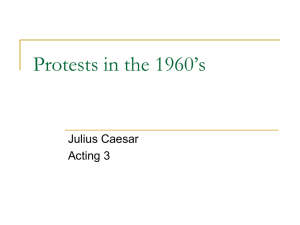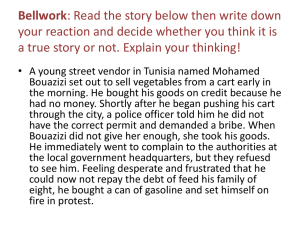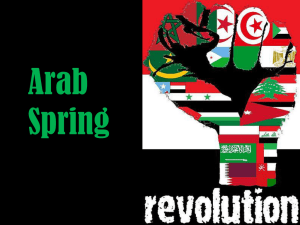ts n omme
advertisement
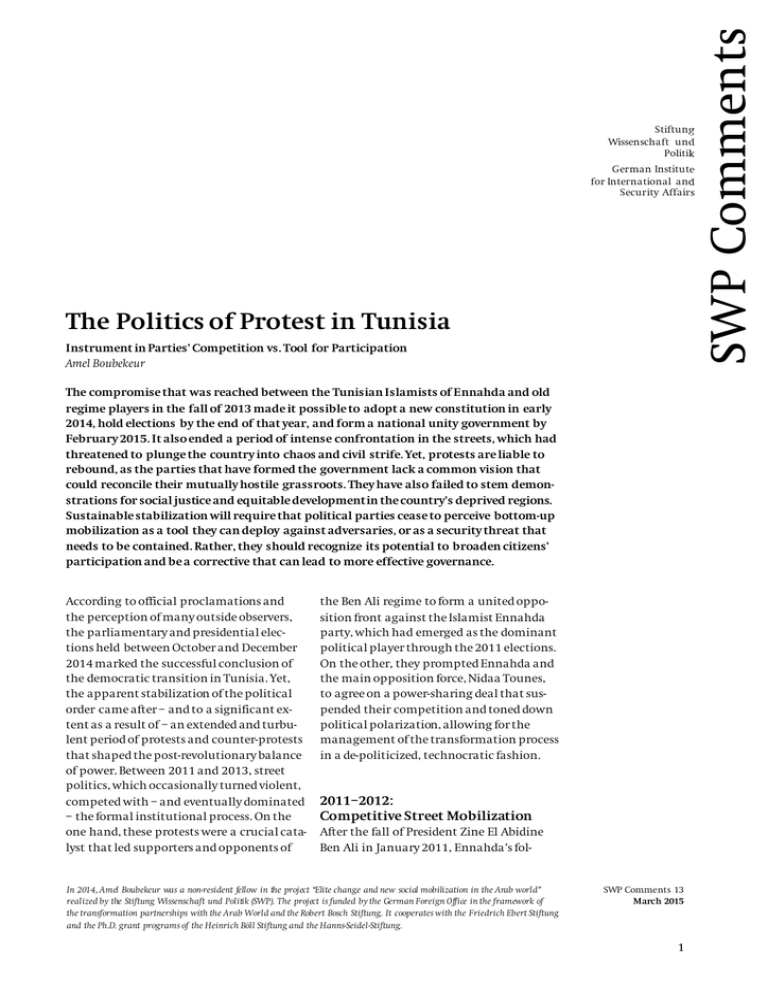
Stiftung Wissenschaft und Politik German Institute for International and Security Affairs The Politics of Protest in Tunisia Instrument in Parties’ Competition vs. Tool for Participation Amel Boubekeur The compromise that was reached between the Tunisian Islamists of Ennahda and old regime players in the fall of 2013 made it possible to adopt a new constitution in early 2014, hold elections by the end of that year, and form a national unity government by February 2015. It also ended a period of intense confrontation in the streets, which had threatened to plunge the country into chaos and civil strife. Yet, protests are liable to rebound, as the parties that have formed the government lack a common vision that could reconcile their mutually hostile grassroots. They have also failed to stem demonstrations for social justice and equitable development in the country’s deprived regions. Sustainable stabilization will require that political parties cease to perceive bottom-up mobilization as a tool they can deploy against adversaries, or as a security threat that needs to be contained. Rather, they should recognize its potential to broaden citizens’ participation and be a corrective that can lead to more effective governance. According to official proclamations and the perception of many outside observers, the parliamentary and presidential elections held between October and December 2014 marked the successful conclusion of the democratic transition in Tunisia. Yet, the apparent stabilization of the political order came after – and to a significant extent as a result of – an extended and turbulent period of protests and counter-protests that shaped the post-revolutionary balance of power. Between 2011 and 2013, street politics, which occasionally turned violent, competed with – and eventually dominated – the formal institutional process. On the one hand, these protests were a crucial catalyst that led supporters and opponents of the Ben Ali regime to form a united opposition front against the Islamist Ennahda party, which had emerged as the dominant political player through the 2011 elections. On the other, they prompted Ennahda and the main opposition force, Nidaa Tounes, to agree on a power-sharing deal that suspended their competition and toned down political polarization, allowing for the management of the transformation process in a de-politicized, technocratic fashion. 2011–2012: Competitive Street Mobilization After the fall of President Zine El Abidine Ben Ali in January 2011, Ennahda’s fol- In 2014, Amel Boubekeur was a non-resident fellow in the project “Elite change and new social mobilization in the Arab world” realized by the Stiftung Wissenschaft und Politik (SWP). The project is funded by the German Foreign Office in the framework of the transformation partnerships with the Arab World and the Robert Bosch Stiftung. It cooperates with the Friedrich Ebert Stiftung and the Ph.D. grant programs of the Heinrich Böll Stiftung and the Hanns-Seidel-Stiftung. SWP Comments 13 March 2015 1 SWP Comments Introduction lowers took to the street together with the political left, the Tunisian General Labor Union (Union Générale Tunisienne du Travail, UGTT), and young people from the interior regions to prevent the regime party, Rassemblement Constitutionnel Démocratique (RCD), from reclaiming power. Yet, competition over revolutionary legitimacy and access to state institutions and resources soon drove them apart. The October 2011 victory of Ennahda in the elections to the National Constituent Assembly (NCA) led to protests against the Islamist party and the coalition it formed with two small, soon to be marginalized, secular parties (Ettakatol and the Congress for the Republic), commonly known as the Troika government. Anti-Troika protests were organized by leftists, intellectuals, the unions, and civil society activists, but also by supporters of the former regime. Supportive coverage by media linked to business allies of Ben Ali further boosted these demonstrations. They campaigned against what they referred to as “a total takeover” of state institutions by the Ennahda through the Troika. Some of the protesters also aimed at challenging the legitimacy that the Islamists had won at the polls by means of “popular legitimacy” in the streets. This included some civil society organizations – such as the General Union of Tunisian Students (Union générale des étudiants tunisiens, UGET), Doustourna (Our Constitution), and the Tunisian Association of Democratic Women – which attempted to use street politics to compensate for the electoral defeat of leftist and centrist parties, to which they were historically connected. More generally, civil society saw street protests as a way to work against the monopoly of political parties over the transition process. Among their successful mobilizations were the sit-in outside the NCA in December 2011 (known as the Bardo protest, named for the neighborhood in which the NCA was situated), which obtained more transparency for the proceedings of the assembly, as well as the August 2012 demonstrations that helped scuttle a SWP Comments 13 March 2015 2 constitutional clause advocated by Ennahda by which the role of women would have been defined as “complementary” rather than equal to men. In these instances, protests served as an important corrective of the formal political process. The Islamist party quickly responded in kind. While officially denying any direct involvement, it openly encouraged its supporters to organize counter-demonstrations. Thus, participants at the 2011 Bardo protest faced a heterogeneous crowd of Ennahda sympathizers and football fans, who denied the “losers” of the elections the right to intervene in the transformation. Throughout the summer of 2012, the Ennahda youth conducted a campaign under the slogan “Ekbess” (“Stay firm!”), urging the leadership to crack down on members of the old guard and provide compensation for victims of Ben Ali from the Islamist milieu. These street actions in favor of “electoral legitimacy” countered the claim to “popular legitimacy” advanced by the opponents of the Troika by showing that Ennahda could mobilize mass support as well. Salafis and the so-called Leagues for the Protection of the Revolution (LPR) were also among the driving forces of these counterprotests. The former represent a heterogeneous group of mostly young, often economically deprived Tunisians whose primary motivation to join the demonstrations was support for a revanchist agenda aimed at putting an end to the cultural and social domination that the pre-revolutionary elite had exercised in the name of secularism. Participation in a larger movement ostensibly oriented toward Islamic values also suited the Salafis’ principled rejection of partisan politics as un-Islamic, and shielded them from police repression, at least to a certain degree. Ennahda’s leaders, in turn, drew leverage from their activities by impressing on leaders of the former regime that they alone had the capacity to control these “unruly masses.” At that time, both Ennahda and the Salafis shared the notion that the revolu- tion had ended the era of the authoritarian exclusion of Islamists and that it should lead to the Islamization of the constitution as well as the universities, among other institutions. From mid-2011 to mid-2012, they rejected the authority of elected leftist teachers’ and students’ unions, organized sit-ins for the right of female students to attend university exams with full-face veil, and pushed for the establishment of mosques on campuses. They also achieved the replacement of state-appointed Imams in many mosques with preachers known for Islamist leanings and disrupted media and cultural events they judged ostensibly “provocative” to Islam, such as an art exhibition held at the Palais Abdellia in the bourgeois neighborhood of La Marsa in June 2012, thus also reclaiming the reappropriation of “secularist enclaves.” Unlike the Salafis, the LPR maintained close coordination with Ennahda. They attended protests staged by the party youth and vice versa, and some activists were members of both. Originally established as neighborhood committees to address the post-revolutionary security void and close to local UGTT chapters, the LPR regrouped as political allies of Ennahda after it came to power and increasingly engaged in violent activities. Many expected that the new dominant force would reward those who were organizing protests on its behalf, once it came to the redistribution of economic and institutional spoils. On many occasions, the LPR demonstrated by threatening mainstream media that criticized Ennahda for allegedly biased appointments, and by intimidating anti-Islamist intellectuals, leftist parties, and later the emerging opposition party Nidaa Tounes. They also often disrupted anti-government meetings and protests, sometimes with violent consequences, such as the clashes that led to the death of the regional Nidaa representative of Tataouine, Lotfi Naguedh, on 18 October 2012. They also cooperated with Salafi imams to organize counter-demonstrations against general strikes initiated by the UGTT. Counter-demonstrations also aimed at curtailing the activities of civil society groups, which the LPR regarded as competitors for revolutionary legitimacy, such as the National Association for the Defense of the Martyrs and the Wounded of the Tunisian Revolution. In addition, Ennahda used its newly acquired institutional power to counter the pressure in the streets. In early 2012, Ennahda minister of the interior, Ali Larayedh, hardened his management of public protests. Quoting the state of emergency statute, he insisted that demonstrations needed his explicit authorization, while applicable law only required prior notification. Also, clashes that had occurred during previous Salafi demonstrations served as a pretext to close the highly symbolic Avenue Habib Bourguiba for all protests. In consequence, violent clashes occurred between anti-Troika protesters and the police (allegedly backed up by the LPR) on Martyrs’ Day, 9 April 2012. Ennahda MP Sadok Chourou went as far as describing protestors as “enemies of God,” who should have their “hands and arms cut off.” Chourou also suggested a constitutional provision awarding a special status to the LPR as enforcers of the “objectives of the revolution.” Although this fell flat, the Leagues acquired an official associational status by June 2012, which they henceforth exploited to organize pro-Troika street action that was authorized by the ministry of the interior. 2012–2013: Rising Confrontation and the Emergence of Nidaa Tounes By 2012, numerous strikes in public companies and protests throughout the country had been damaging investor confidence and the tourism industry. This led to an erosion in the support that businessmen linked to the old regime and international donors had initially given to Ennahda in exchange for the party’s compliance with their liberal economic agendas. Over the summer and fall, those economic difficul- SWP Comments 13 March 2015 3 ties, as well as delays in writing the constitution, also multiplied the protests against the Troika. Supporters of the old regime then exploited them to change the balance of power. In July 2012, the veteran politician Beji Caid Essebsi, who had held high offices under both Ben Ali and Habib Bourguiba, established a new party, Nidaa Tounes (Call of Tunisia). The new formation quickly attracted a heterogeneous array of followers and allies united by the fear of Ennahda’s increasing hegemony. It also attracted many of those who had been sidelined by the project of the revolutionaries or by Ennahda’s government, such as RCD members, leftist and secular activists, as well as members of the UGTT and the national employers’ union (Union Tunisienne de l’Industrie, du Commerce et de l’Artisanat, UTICA). Through defections from other parties, the new force obtained up to 11 seats in the NCA; without having been elected, Nidaa Tounes also formed a broad coalition with centrist parties under the label “Union for Tunisia.” The leftist alliance Popular Front, for its part, initially declined the invitation to form an even broader antiIslamist coalition. At the same time, Ennahda started to lose the competition in the streets. The assassination of the Popular Front leader, Choukri Belaid, on 6 February 2013, was a crucial turning point. Since Ennahda had previously blamed Belaid for the regional and labor protests that were challenging the government, the party stood now accused of sharing political responsibility in the crime. Protests and general strikes called by the UGTT to demand the resignation of the Troika government brought between 40,000 (according to the interior ministry) and 100,000 (according to the demonstrators) people to the streets. Ennahda’s supporters responded with marches in support of “legitimacy” (of the sitting government), for “unity,” and “against violence.” Yet, the ruling majority was clearly thrown on the defensive. On 25 July 2013, the assassination of Mohamed Brahmi, another pro- SWP Comments 13 March 2015 4 minent figure of the Popular Front, prompted the latter to finally join forces with the Union for Tunisia and form the National Salvation Front (NSF). All relevant political parties outside the Troika had now joined ranks, and as most of them withdrew their representatives from the NCA, the constitutional process was on the brink of collapse. With the support of the NSF members, the UGTT, and UTICA, the Popular Front launched the “Rahil” (“Departure”) campaign, which involved massive sit-ins and demonstrations throughout the country calling for the dissolution of the NCA. By gathering around 150,000 people in Tunis on 6 August 2013, the NSF claimed that it represented a “national consensus” that could override the electoral legitimacy of the Ennahda-controlled government. Among the participants were activists who had been involved in the revolution and the defense of its objectives from the beginning, but also middle-class Tunisians taking to the streets for the first time, attracted by Essebsi’s discourse in favor of a return to order. Rather than stressing secular values, as Nidaa Tounes had done, the NSF emphasized the importance of the traditional Tunisian Islamic identity in order to underline the national consensus it claimed to represent, reach out to Ennahda’s disappointed voters, contest the Islamist party’s sole claim on religious values, and denounce its alleged foreign allegiances, in particular to Qatar. Among the protest events were collective Iftars (the breaking of the fast during the month of Ramadan, which coincided with the evening protests), and Imams were invited to deliver speeches. In this, participants stressed the need to put the transition back on track – meaning, ending Ennahda’s control over it. Political deadlock, the NSF’s massive street mobilization, and the pressure from an international community fearing an “Egyptian scenario” (i.e., a bloody struggle between Islamists and old regime members) finally drove Ennahda and its opponents to a compromise. Instead of continuing the confrontation in the streets, they agreed to a power-sharing formula that would suspend the competition for power, and thus allow negotiations for a new constitution and preparations for presidential elections. 2013–2014: A Fragile Consensus and the End of Street Politics It did not take long for differences to arise in the broad coalition against Ennahda. Whereas Nidaa Tounes used “Rahil” as a platform to compensate for its lack of electoral and revolutionary legitimacy, the leftist parties saw the protests as an opportunity to reconnect to the grassroots. Also, while the Popular Front pushed for the creation of a “Council of National Salvation” that would have superseded the existing institutions, Nidaa used the leverage of the protests to rehabilitate members of the former regime. Despite continued protests in the interior regions, the UGTT and the NSF ended their demonstrations in December 2013 after Ennahda accepted to join the so-called Quartet’s (UGTT, UTICA, the Bar Association, and the Tunisian League of Human Rights) initiative of a national dialogue with Nidaa Tounes, and following their subsequent agreement on a caretaker government of technocrats that would govern until elections, to be held in 2014. This consensus effectively marginalized the agenda of the Popular Front and leftist civil society organizations, which had been the most active in organizing the protests on the ground. The UGTT earned national and international recognition for its mediating role, but ended up in an awkward position when the government it helped to install pursued policies that negatively affected its members, such as reductions in public employment levels. In the end, the 2014 technocratic government as well as the 2015 national unity government both implied ending street mobilization and contentious action. This development put significant strain on the alliance as well as on their respective grassroots. On Nidaa’s side, some of the dissenters who had carried the anti-Ennahda protests were elected to parliament in the 2014 polls, and thus have pursued their opposition to any cooperation with the Islamists within the political institutions. Leftist and civil society activists attempting to continue demonstrations, on the other hand, have often been treated harshly by the security services. Ennahda likewise worked to chase its supporters off the streets. Salafis were the first victims of its turnaround. Strictly speaking, a first rupture had already occurred in March 2012, when Ennahda had accepted to drop any direct reference to Islamic Sharia from the constitution. In 2011 and early 2012, the party still considered Salafis to be a pliant reservoir of protesters that could be moved at will. Their stance started to change when the Salafis refused to convert themselves into a legal political party and instead intensified their independent protests. When four Salafis were apprehended for the murder of Belaid in late February 2013, the political cost of being associated with these groups became unaffordable. In May 2013, when Ennahda had already started negotiations with the opposition, minister of the interior Larayedh refused to authorize a Salafi congress in Kairouan – a follow-up to an event that he had allowed a year before – causing violent riots in deprived Tunis neighborhoods. Throughout 2013 and 2014, hunger strikes and protests by Salafis against police harassment under terrorism charges were regularly and often violently dispersed. Ennahda’s compromises with Nidaa also drew resistance from the LPR. Throughout 2013, the Leagues mobilized to pressure Ennahda into insisting on a constitutional clause that would have excluded former RCD members from political office. The party was deeply divided over the issue, until its leader, Rashid al-Ghannouchi, finally abandoned the proposal in August 2013. The LPR were equally dissatisfied when the party agreed to enter the national dialogue with Nidaa Tounes in October 2013, as the dissolution of the LPR was one of the conditions put forward by the Quar- SWP Comments 13 March 2015 5 tet’s platform. It finally went into effect on 26 May 2014. At the same time, elements of the LPR on the one side and ex-RCD militias posing as Nidaa supporters on the other have remained active and attempted to disrupt the election campaigns of the opposing sides in the fall of 2014. Protests Against Political and Economic Marginalization Although the rival mobilizations for and against Ennahda monopolized most attention, young unemployed people, workers affiliated to local UGTT chapters, and civil society activists in the marginalized regions of Tunisia continued to protest for social justice after Ben Ali’s fall. Yet, they were increasingly denigrated as a threat to the consolidation of post-revolutionary politics and the economy. The leaders of the Islamist and the technocrat government alike all condemned labor action as being engineered by their political opponents, alluding first to the left and former RCD members, and after late 2013 to pro-Islamist actors. These local protests reveal the potential for conflict that has been created by an elite-driven interpretation of the revolution’s objectives. Tunisia’s mainstream media, external actors, and national policymakers all share the view that the success of the transformation lies in the adoption of a constitution and the organization of pluralist elections. Negotiations on the elite level aim at subduing the unruly postrevolutionary polity, reasserting central control, and complying with the conditions attached to international aid, such as the privatization of natural resources. In contrast, protesters from Tunisia’s interior regions believe that the revolution was about ending political and economic exclusion and about decentralizing power. Through their mobilizations, they continue to criticize favoritism and police violence and demand re-distributional justice. Pushing for the exclusion of those perceived as corrupt supporters of the old regime has SWP Comments 13 March 2015 6 also motivated numerous protests in the regions. During the 2010/2011 uprising and its immediate aftermath, protests led by revolutionary youth and their families drove RCD governors, police officers, and even managers of public companies out of many towns. In response to state violence that occurred during the revolution (around 1,500 arrested, 700 injured, and 300 dead), victims’ families and supporters formed associations that conducted demonstrations, sitins, and hunger strikes – first for the release of the arrested, then for compensation and medical care for the victims, and the prosecution of those responsible. They were joined by former political prisoners and members of the UGET and the Union of Unemployed Graduates (Union des diplômés chômeurs, UDC) – many of whom had been banned from employment for political reasons under the Ben Ali regime and who now demand rehabilitation and professional reintegration. However, these protesters faced significant obstacles that prevented them from obtaining broad support. Although demonstrations for or against the Troika could count on support from powerful political actors and the media, unaffiliated groups had few allies. After leading the revolution and bringing down the two first post-Ben Ali cabinets, these groups that had been demonstrating in the capital were quickly repressed by Essebsi’s interim government, installed in March 2011, and asked by the rest of the opposition to return to their regions. What is more, many of those protests in favor of the enforcement of the revolution’s objectives have remained technically illegal. An amnesty law, finally passed by the NCA on 2 June 2014, only pardons illegal acts committed during demonstrations that happened during the period between 17 December 2010 and 28 February 2011. This left the initiators of all protests that occurred during the rest of the transition period exposed to prosecution and gave the authorities ample leverage to intimi- date anyone who refused to comply with the post-2013 consensus on ending street politics. In 2014, protest leaders from regions such as Kasserine and Sidi Bouzid were selectively indicted for alleged gang formation, defamation of former RCD members, non-authorized sit-ins, and violence against police stations. Young human rights and community activists, bloggers, and rappers have also complained about police harassment and have demonstrated against ongoing torture, suspecting a concerted campaign to silence them in preparation of a return to repressive rule. With the multiplication of terrorist attacks near or in the marginalized regions in 2013 and 2014, public opinion and political parties increasingly converged on the need to close ranks and reinforce security. This played into the hands of the Tunisian police union’s lobbying for the rehabilitation of policemen who supposedly “only applied the law” when they repressed and killed young revolutionaries. Indeed, several former high-ranking security officials convicted of involvement in regime abuses had their prison sentences reduced from 20 to 3 years in April 2014. Since that was precisely the time they had already served, the ruling allowed them to walk free. Subsequent hunger strikes and demonstrations by families of the victims and human rights activists remained without effect and received little media attention. Economic marginalization has further fueled protests in the regions. The UDC and local independent groups defending the rights of the unemployed and precarious workers have continued to call for a revolution by the poor. Their demonstrations especially target the economic and development policies of national representatives that they consider to be negligent, corrupt, and regionalist, that is, biased toward the more developed urban and coastal regions. After the departure of Ben Ali, many sit-ins were organized against local governors and governors nominated by Ennahda. The premises of the party were torched in several cities in 2012 and 2013, as protest- ers accused its representatives of favoritism in the distribution of public sector jobs. Protestors from the regions joined the peaceful marches against the Troika government in the summer of 2013 but remained critical of the persistence of clientelist networks under the technocrat government that followed. They have also rejected the successive governments’ calls for a “social truce,” and continued mobilizing against austerity and tax policies. Protests often end with tax offices and banks being ransacked. Wildcat strikes that force the temporary closure of public administrations and companies and private businesses have continued to erupt. Strikers and sit-inners primarily denounce working conditions, youth unemployment, and favoritism in public recruitment. Protesters block roads, launch hunger strikes, and even stage suicide attempts in front of public companies to push for better development and services for their regions, such as public hospitals, supplies of water and gas, etc. Competition between rival local groups over informal or illegal resources – such as smuggling of arms, goods, and petrol with Algeria and Libya – has also hardened. In April 2014, and again in February 2015, attempts to enhance state control over Tunisia’s borders triggered violence in the south: In 2014 the UGTT office in Ben Guerdane was torched when the union declined to support the protest. As the unity government formed in February 2015 is expected to adopt new austerity policies, more socioeconomic protests are likely to occur. The consensus between former opposition parties, old regime representatives, and unions to declare the revolution over has allowed them to label remaining protests in the regions as security threats. The protesters themselves have lost trust in national representatives and do not possess any stake in the power bargains negotiated in the capital. Hence, demonstrations asking for dignity and social justice are slowly overshadowed by amorphous groups of protestors that include smugglers and juvenile delinquents asking for their share of the SWP Comments 13 March 2015 7 spoils. Those may turn out to be much more difficult to control than activists who are pushing for what they consider to be the revolution’s true objectives. Conclusions and Recommendations © Stiftung Wissenschaft und Politik, 2015 All rights reserved These Comments reflect solely the author’s views. SWP Stiftung Wissenschaft und Politik German Institute for International and Security Affairs Ludwigkirchplatz 3­4 10719 Berlin Telephone +49 30 880 07-0 Fax +49 30 880 07-100 www.swp-berlin.org swp@swp-berlin.org ISSN 1861-1761 SWP Comments 13 March 2015 8 Tunisia’s European partners have seen institutional achievements as being crucial to the country’s political consolidation. They should now focus on helping Tunisian actors address the challenges that are likely to arise from the fragile compromise between Ennahda and Nidaa Tounes. Street protests are set to continue because the grassroots of Islamist constituencies still feel excluded from mainstream politics. There are also no effective channels to feed the demands of the interior regions and of civil society organizations into central decision-making processes. Thus, although a firm position against militias, rogue security forces, and violent groups is required, rather than backing attempts to repress protests in the name of security – which is liable to create the very instability it ostensibly aims to avert – Tunisia’s European partners should encourage the new government to transform them into a component of a democratic political culture. To this end, three elements are key: First, street protests should be seen as opportunities to enhance political participation and improve governance. In the past years, they have often occurred when formal channels, such as elections, debates in the NCA, or the national dialogue, did not function and local governance left much to be desired. Protests should be seen as an indicator of grievances that need to be addressed and lead to the establishment of mechanisms such as local consultative structures and public hearings, which can reconnect citizens and public institutions and work against exclusion. Such mechanisms could be supported in the frame of the European Neighborhood Partnership framework. Second, European Union member states should complement their bilateral security and judicial partnerships with Tunisia with policies that support the country in harmonizing its handling of manifestations with international standards. Police performance has to be governed using clear standards and rules of engagement and monitored by neutral bodies. Threats of terrorism should not be exploited to justify restrictions to the freedom of assembly and expression. Rather, it is high time to revise authoritarian practices, such as military tribunals for civilian protesters, and to adapt the law on demonstrations to international standards. Third, European political parties, unions, foundations, and NGOs should support training and encourage agreements that restore crucial trust between citizens and the police. In this vein, the results of parliamentary inquiries into post-revolutionary violence should be made public. European experiences with reconciliation processes after violent conflicts should be used to inspire reconciliation programs organized in partnership with local associations, especially in deprived regions and neighborhoods, where the memory of violent conflicts is still vivid.
